Tejas Aircraft
| Tejas | |
|---|---|
.jpg)
|
|
| Tejas in flight | |
| Role | Multirole light fighter |
| National origin | India |
| Manufacturer | Hindustan Aeronautics Limited |
| Design group |
Aeronautical Development Agency Defence Research and Development Organisation National Aerospace Laboratories |
| First flight | 4 January 2001 |
| Introduction | 17 January 2015 [1] |
| Status | In service [2] |
| Primary user | Indian Air Force |
| Produced | 2001–present |
| Number built | 33 (including 16 prototypes as of March 2019) [3] |
| Program cost | ₹ 7,399.69 crore (US$1 billion) (LCA total in 2015) [4] |
| Unit cost |
₹162 crore (US$23 million) for Mk. 1
[5]
₹310 crore (US$43 million) for Mk. 1A [6] [ better source needed ] |
| Developed into | HAL Tejas Mark 2 |
HAL Tejas is an Indian single-engine, delta wing, multirole light fighter designed by the Aeronautical Development Agency (ADA) and Hindustan Aeronautics Limited (HAL) for the Indian Air Force and Indian Navy. It came from the Light Combat Aircraft (LCA) programme, which began in the 1980s to replace India's ageing MiG-21 fighters. In 2003, the LCA was officially named "Tejas". [7]
Tejas has a tail-less compound delta-wing configuration with a single dorsal fin. This provides better high-alpha performance characteristics than conventional wing designs. [8] Its wing root leading edge has a sweep of 50 degrees, the outer wing leading edge has a sweep of 62.5 degrees, and trailing edge has a forward sweep of four degrees. It integrates technologies such as relaxed static stability, fly-by-wire flight control system, multi-mode radar, integrated digital avionics system and composite material structures. It is the smallest and lightest in its class of contemporary supersonic combat aircraft. [9] [10]
The Tejas is the second supersonic fighter developed by Hindustan Aeronautics Limited (HAL) after the HAL HF-24 Marut. As of 2016, the Tejas Mark 1 was in production for the Indian Air Force (IAF) and the naval version was undergoing flight tests for Indian Navy (IN). The projected requirement for the IAF was 200 single-seat fighters and 20 twin-seat trainers, while the IN expected to operate at least 40 single-seat fighters. The first Tejas IAF unit, No. 45 Squadron IAF Flying Daggers was formed on 1 July 2016 with two aircraft. Initially stationed at Bangalore, 45 Squadron was later relocated to its home base at Sulur, Tamil Nadu. [11] [12] The Minister of State for Defence, Subhash Bhamre, reported to parliament that the indigenous content of the Tejas was 59.7% by value and 75.5% by number of line replaceable units in 2016. [13]
As of 2019, the planned number of Tejas in Indian Air Force inventory, is a total 324 aircraft of several variants. [14] The first batch consists of 40 Mark 1 aircraft, 16 IOC standard (already delivered) [15] and 16 FOC standard (delivery to commence by end of 2019), [16] followed by 8 trainers. [17] Next 83 are to be of upgraded Mark 1A standard. [18] By the time these first 123 are delivered, the Tejas Mark 2 is expected to be ready for series production by 2025–26. [19]
Development
See also: Timeline of HAL Tejas
Origins

In 1969, the Indian government accepted the recommendation by its Aeronautics Committee that Hindustan Aeronautics Limited (HAL) should design and develop a fighter aircraft around a proven engine. Based on a 'Tactical Air Support Aircraft' ASR markedly similar to that for the Marut, [20] HAL completed design studies in 1975, but the project fell through due to inability to procure the selected "proven engine" from a foreign manufacturer and the IAF's requirement for an air superiority fighter with secondary air support and interdiction capability remained unfulfilled. [21]
In 1983, IAF realised the need for an Indian combat aircraft for two primary purposes. The principal and most obvious goal was to replace India's ageing MiG-21 fighters, which had been the mainstay of the IAF since the 1970s. The "Long Term Re-Equipment Plan 1981" noted that the MiG-21s would be approaching the end of their service lives by the mid-1990s, and that by 1995, the IAF would lack 40 percent of the aircraft needed to fill its projected force structure requirements. [22] The LCA programme's other main objective was an across-the-board advancement of India's domestic aerospace industry. [23] The value of the aerospace "self-reliance" initiative is not simply the aircraft's production, but also the building of a local industry capable of creating state-of-the-art products with commercial spin-offs for a global market. [24]
In 1984, the Indian government chose to establish the Aeronautical Development Agency (ADA) to manage the LCA programme. While the Tejas is often described as a product of Hindustan Aeronautics Limited (HAL), responsibility for its development belongs to ADA, a national consortium of over 100 defence laboratories, industrial organisations, and academic institutions with HAL being the principal contractor. [25] The government's "self-reliance" goals for the LCA included the three most sophisticated and challenging systems: the fly-by-wire (FBW) flight control system (FCS), multi-mode pulse-doppler radar, and afterburning turbofan engine. [26]
The IAF's Air Staff Requirement for the LCA were not finalised until October 1985. This delay rendered moot the original schedule which called for first flight in April 1990 and service entry in 1995; however, it also gave the ADA time to better marshal national R&D and industrial resources, recruit personnel, create infrastructure, and to gain a clearer perspective of which advanced technologies could be developed locally and which would need to be imported. [21] [27]
Project definition commenced in October 1987 with France's Dassault-Breguet Aviation as consultants. Dassault-Breguet were to assist in the design and systems integration of the aircraft, with 30 top-flight engineers reported to have flown to India to act as technical advisers to IADA, in exchange for $100m / ₹560 crore (equivalent to ₹56 billion or US$790 million in 2019), this phase was completed in September 1988. [27] [28]
LCA programme
A review committee was formed in May 1989, which reported that infrastructure, facilities and technologies in India had advanced sufficiently in most areas and that the project could be undertaken. [29] A two-stage full-scale engineering development (FSED) process was opted for. [22] [29] In 1990, the design was finalised using the "control configured vehicle" concept to define a small tailless delta winged aircraft with relaxed static stability (RSS) for enhanced manoeuvrability. [9] [30] [29]
Phase 1 commenced in April 1993, [22] and focused on "proof of concept" and comprised the design development and testing (DDT) of two technology demonstrator aircraft which were named as TD-1 and TD-2. This would be followed by the production of two prototype vehicles (PV-1 and PV-2), TD-1 finally flew on 4 January 2001. [29] FSED Programme Phase-I was successfully completed in March 2004 and cost ₹2,188 crore. [22]
The relaxed static stability (RSS) was an ambitious requirement. In 1988, Dassault had offered an analogue flight control system (FCS), but the ADA recognised that digital FCSs would supplant it. [26] First flying in 1974, the General Dynamics F-16 was the first production aircraft designed to be slightly aerodynamically unstable to improve manoeuvrability. [31]
In 1992, the LCA National Control Law (CLAW) team was set up by the National Aeronautics Laboratory (now called National Aerospace Laboratories) to develop India's own state of the art fly-by-wire FCS for the Tejas. [32] [33] In 1998, Lockheed Martin's involvement was terminated due to a US embargo in response to India's second nuclear tests in May of that year. [34] [35]
Another critical technology is the multi-mode radar (MMR). The Ericsson/Ferranti PS-05/A I/J-band multi-function radar was initially intended to be used, [36] and also used on Saab's JAS 39 Gripen. However, after examining other radars in the early 1990s, the Defence Research and Development Organisation (DRDO) became confident that local development was possible. HAL's Hyderabad division and the Electronics and Radar Development Establishment (LRDE) were selected to jointly lead the MMR programme, and work commenced in 1997. [37] The Centre for Airborne Systems (CABS) is responsible for the MMR's test programme. Between 1996 and 1997, CABS converted the surviving HAL/HS-748M Airborne Surveillance Post (ASP) into a testbed for the LCA's avionics and radar. [38]
The NAL's CLAW team completed integration of the flight control laws with the FCS software performing flawlessly for over 50 hours of pilot testing on TD-1, resulting in the aircraft being cleared for flight in January 2001. The automatic flight control system (AFCS) has been praised by all test pilots. [39] Phase 2 commenced in November 2001, [22] and consisted of the manufacturing of three more prototype vehicles (PV-3, PV-4 and PV-5), leading to the development of the final version that would join the air force and the navy and 8 Limited Series Production (LSP) aircraft, and establishment of infrastructure for producing 8 aircraft per year. [29] The phase cost ₹3,301.78 crore, and an additional amount of ₹2,475.78 crore was given for induction into Indian Air Force by obtaining IOC and FOC. The total cost for development of Tejas (including PDP, Phase 1 and Phase 2) was ₹7,965.56 crore as of August 2013. [22]
By mid-2002, the MMR had reported suffered major delays and cost escalations. By early 2005, only the air-to-air look-up and look-down modes — two basic modes — were confirmed to have been successfully tested. In May 2006, it was revealed that the performance of several modes being tested "fell short of expectations." [40] As a result, the ADA was reduced to running weaponisation tests with a weapon delivery pod, which is not a primary sensor, leaving critical tests on hold. According to test reports, there was a serious compatibility issue between the radar and the LRDE's advanced signal processor module (SPM). Acquisition of an "off-the-shelf" foreign radar is an interim option being considered. [37] [41] [42]
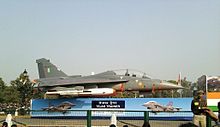 Tejas Trainer at 62nd Republic Day of India Parade, New Delhi
Tejas Trainer at 62nd Republic Day of India Parade, New Delhi
Of the five critical technologies the ADA identified at the beginning of the programme as required to design and build a new fighter, two have been successful: the development and manufacture of carbon-fibre composite (CFC) structures and skins, and a modern glass cockpit. ADA has a profitable commercial spin-off in its Autolay integrated automated software for designing 3-D laminated composite elements (which has been licensed to both Airbus and Infosys). [26] By 2008, 70% of the LCA's components were being manufactured in India, the dependence on imported components was stated to be progressively reduced over time. However, problems were encountered with the other three key technology initiatives. [43] For example, the intended engine, the GTRE GTX-35VS Kaveri, [44] had to be replaced with an off-the-shelf foreign engine, the General Electric F404.
Kota Harinarayana was the original Programme Director and Chief Designer for the Tejas Programme. [45] [46]
On 26 February 2016, Defence Minister Manohar Parrikar said in the Lok Sabha that the Indian Air Force would accept 3–4 Tejas (IOC version) that year and eventually stand up a total of 8 squadrons within 8 years. He also said, "We are also in the process of approving the second line of manufacturing to the HAL so that they can produce 16 aircraft per year." [47] In October 2015, IAF Air Chief Marshal Arup Raha confirmed that the air force plans to order 123 (six squadrons) of Tejas Mark 1, triple the 40 aircraft it had previously committed to buying. Later it was declared that those 83 additional Tejas ordered to be the upgraded Mark 1A version. [18] On 7 November 2016, Parrikar approved procurement of 83 Tejas for the IAF, at a cost of ₹50,025 crore (US$7 billion). [48] The order for those is expected to be placed by the end of 2019, after the unit price was negotiated between ₹250-₹275 crores (around $40 million) per unit. [49] By March 2020, the HAL, hopes to expand its production capacity to at least a squadron (16+) of aircraft every year. [50]
In 2018, IAF formally committed to buying 324 Tejas aircraft of all versions, if HAL and Aeronautical Development Agency (ADA) can deliver an acceptable quality Tejas Mark 2 in time. [14] The Defence Acquisition Council (DAC) on 18 March 2020 cleared the ₹390 billion ($5.2 billion) procurement deal for 83 Tejas Mk.1A, including 73 single-seat fighters and 10 dual-seat trainers. [51] HAL will now finalize the contract and the proposal will be reviewed by the Cabinet Committee on Security (CCS). According to HAL, the first Tejas Mk.1A will fly by 2022 with serial production starting in 2023. The first squadron of Tejas Mk.1A will be delivered by 2025 and delivery of all 83 aircraft will complete before 2029. [52] [53] The Tejas Mk.1A will support the R-77 and Python-5, along with the Astra Mk.1. The IAF also want strong aircraft maintenance package and aircraft panel inter-changeability that can be carried out at squadron level in a minimum amount of time using quick-release fasteners to reduce foreign object damage (FOD). Line-replaceable units (LRU)s are also expected to be pre-positioned. [54]
Prototypes and testing
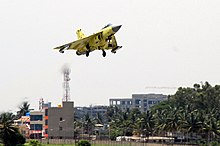 First flight of Tejas LSP-4, 2 June 2010
First flight of Tejas LSP-4, 2 June 2010
In March 2005, the IAF placed an order for 20 aircraft, with a similar purchase of another 20 aircraft to follow. All 40 were to be equipped with the F404-GE-IN20 engine. [55] [56] In December 2006, a 14-member "LCA Induction Team" was formed at Bangalore to prepare the Tejas and assist with its introduction into service. [57]
On 25 April 2007, the first Limited Series Production (LSP-1) Tejas performed its maiden flight, achieving a speed of Mach 1.1 (1,347.5 km/h; 837.3 mph). [27] The Tejas completed 1,000 test flights and over 530 hours of flight testing by 22 January 2009. [27] [58] In 2009, a Tejas achieved a speed of over 1,350 kilometres per hour (840 mph) during sea level flight trials at INS Hansa, Goa. [27] [59]
On 16 June 2008 LSP-2 made its first flight [27] followed by the first flight of the trainer variant in November 2009. [60] On 23 April 2010, LSP-3 flew with a hybrid version of the Elta EL/M-2032 multi-mode radar; [27] [61] in June 2010, LSP-4 made its maiden flight in an IAF Initial Operating Clearance (IOC) configuration. [27] [62] By June 2010, the Tejas had completed the second phase of hot weather trials in an IOC configuration with the weapons system and sensors integrated. [63] Sea trials were also being carried out. [64] On 19 November 2010, LSP-5 with IOC standard equipment started flight trials. [65]
In December 2009, the government sanctioned ₹8,000 crore to begin production of the fighter for the Indian Air Force and Indian Navy. The Indian Navy has a requirement for 50 Tejas aircraft and the first prototype, NP-1 was rolled out in July 2010. [66] IAF ordered 20 additional Tejas fighters after the defence acquisition council cleared the plan. [67] In December 2014 the LCA Navy successfully conducted ski-jump trials at SBTF, INS Hansa. The navy variant has a special flight control law mode. It controls a hands-free take-off, which reduces the pilot workload, as the ramp launches the aircraft on an upward flight path. [68] [69]
In November 2010, it was reported that the Tejas Mk 1 reportedly fell short of the relaxed Air Staff Requirements stipulated for limited series production (LSP) aircraft. The areas that did not meet requirements were power to weight ratio, sustained turning rate, maximum speeds at low altitudes, AoA range, and weapon delivery profiles; the extent of the deficiencies was classified. [70] On 9 March 2012, LSP-7 took to its maiden flight from HAL airport. [27] The Naval LCA made its first flight, almost two years after being rolled out, on 27 April 2012. [71]
In September 2011, weapons tests, including bombing trials, began at Pokhran range, to be followed by missile trials at Goa. [72] On 27 June 2012, three Tejas (LSP 2, 3 and 5) aircraft completed bombing runs in the desert of Rajasthan, using precision laser-guided 1,000 lb bombs and unguided bombs. [73] The Tejas had completed 1,941 flights by July 2012. [74]
In the later half of 2012, the Tejas was grounded for over three months due to a serious safety issue which arose with the introduction of a new pilots' helmet, which protruded above the ejection seat. There was concern that, during an ejection, the helmet would strike the canopy before the canopy was released. Flight tests resumed in November 2012 after the ejection system had been modified. [75] LSP 8 had a successful maiden test flight on 31 March 2013, [76] and the programme had completed 2,418 test flights by 27 November 2013. [74] [77] On 31 March 2013, LSP-8 took to its maiden flight from HAL airport. [27] On 8 November 2014, PV-6(KH-T2010), a trainer variant, completed its first test flight. [78]
Out of a total of 35 major avionics components and line-replaceable units (LRUs), only three involve foreign systems. [79] These are the multi-function displays (MFDs) by Sextant (France) and Elbit (Israel), [80] the helmet-mounted display and sight (HMDS) cueing system by Elbit, [80] and the laser pod supplied by Rafael (Israel). [81] Production aircraft are expected to have MFDs from Indian suppliers. A few important items of equipment (such as the Martin-Baker ejection seat) have been imported. [79] As a consequence of the embargo imposed on India after its nuclear weapons tests in May 1998, many items originally planned to be imported were instead developed locally; these sanctions contributed to the prolonged delays suffered by the LCA. [79]
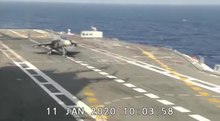 Play media
Play media
Indian test pilots have praised Tejas' high-speed handling and say the Tejas is the IAF's most "pilot friendly" fighter. [82] [83] Group Captain Samrath Dhankhar of the Indian Air Force, the commanding officer of its 45 Sqn "The Flying Daggers" said about Tejas that it responds to pilot inputs in the entire flight envelope very well, with no need to be at certain speeds to get the maximum out of it. [84]
_MK1_undertaking_maiden_Take-Off_from_INS_Vikramaditya_(2).jpg) First take-off of Naval Tejas from the aircraft-carrier INS Vikramaditya on 12 January 2020.
First take-off of Naval Tejas from the aircraft-carrier INS Vikramaditya on 12 January 2020.
A two-seater naval variant of Tejas successfully completed its first arrested landing on 13 September 2019 at the Shore Based Test Facility (SBTF) in Goa. Once the aircraft completes several successful trials on the SBTF, it will demonstrate a landing on the aircraft carrier INS Vikramaditya. [85]
On 11 January 2020, the Naval LCA Tejas successfully carried out its first arrested landing on the aircraft-carrier INS Vikramaditya. [86] [87] On 12 January 2020, Tejas performed its first ski-jump assisted take-off from the aircraft-carrier. [88]
After the successful completion of laboratory trials, Tejas Mk.1 platform will start flight trials with DRDO developed on-board oxygen generation system (OBOGS) in 2020. [89]
Operational clearance
On 10 January 2011, IOC, allowing IAF pilots to fly the Tejas, was awarded by Defence Minister A K Antony to Chief of Air Staff Air Chief Marshal P V Naik. [90] The IAF raised the first squadron in Bangalore to iron out issues with ADA and HAL, and eventually based these fighters at Sulur Air Force Station, Coimbatore in the southern state of Tamil Nadu. The No. 45 Squadron IAF "Flying Daggers" was the first to get their MiG-21s replaced by Tejas aircraft at the base. [91] Tejas' Final Operational Clearance (FOC) was repeatedly delayed since 2011. [92] [93] [94]
HAL was instructed by the Indian government to strictly adhere to deadlines to ensure Initial Operational Clearance-II by the end of 2013 and Final Operational Clearance (FOC) by the end of 2014. [95] On 20 December 2013, IOC-II was issued, after which the aircraft was cleared to be flown by regular IAF pilots and begin induction into squadron service. To fulfill the IOC-II standard, the aircraft was certified to carry close to three tons of weapons including laser-guided 500 kg bombs and short-range R-73 missiles, [96] [97] reach top speeds of 1,350 km per hour, withstand turns up to 7 g, reach angle of attack of 24 degrees (from 17 degrees initially), and have an operational radius of 400–500 km. [98] [99]
To expand the flight envelope to meet service requirements, the programme enlisted assistance from EADS. [100]
These modifications were originally expected to be completed within 15 months of IOC-II, but realistically took far longer. [101] [102]
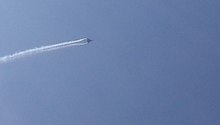 Play media
Play media
The Final Operational Clearance (FOC) campaign began in December 2013, with three aircraft from Tejas flight-line successfully completing advanced weapon trials. The campaign was held in Jamnagar. New weapons were integrated on the aircraft.[103] As part of the FOC, the aircraft is being readied for all-weather trials in Bangalore and in Gwalior. Tejas took its maiden flight in January 2001, and by December 2013, it had completed 2,587 sorties covering over 1,750 hours. [103] In July 2014, the FOC was pushed back as six or more aircraft were needed for testing and only one had been produced then. [104] Tejas received IOC-II clearance on 17 January 2015. [105]
In February 2016, LSP-7 test-fired the BVRAAM Derby missile on a BNG (Ballistic Non Guided) mode in Jamnagar as part of its scheduled weapon trials. These weapon trials are part of the Final Operational Clearance (FOC) mandate. It was the 169th flight of LSP-7 and was piloted by Group Capt Rangachari of National Flight Test Centre. The aircraft is also scheduled to fire a Close Combat Missile (CCM) Python-5 as part of the FOC trials. The LSP-7 along with LSP-4 were part of Indian flying assets at the Bahrain International Air Show (BIAS-2016). [106]
On 12 May 2017, Tejas successfully demonstrated an Air-to-Air Beyond Visual Range (BVR) missile firing capability by releasing Derby Air-to-Air BVR missile in RADAR guided mode. The missile launch was performed in lock-on after launch mode. [107] The missile destroyed its manoeuvrable aerial target with pinpoint precision at the Interim Test Range, Chandipur in Odisha. [108]
In November 2017, it was reported that the Indian Air Force told the government that the Tejas alone is inadequate for the single-engined fighter program with insufficient flight endurance, smaller payload capacity, increased maintenance hours, etc. compared to larger medium combat aircraft contending in the Indian MRCA competition and may augment them, but cannot be an alternative. [109] HAL's chief rejected the criticisms and called the Tejas a world class fighter jet that can fill its defined role. He also mentioned that minimum life span of Tejas is 30 years which can be extended. [110] HAL CMD T Suvarna Raju also stated that HAL delivered five Tejas as of 19 November 2017, which have made more than 600 flights. [111]
In February 2018, refuelling of Tejas with the engine running—known as "hot refuelling"—was carried out. Hot refuelling capability is one of the requirements for Tejas Mk 1A and is expected to shorten the turnaround time between sorties. [112]
In August 2018, the naval variant of the Tejas conducted its first "taxi-in" engagement on a naval platform in Goa to prove its hook-arrester system. The Indian Defence Minister, Nirmala Sitharaman's backing of the Tejas programme allowed the restarting of tests and gave its naval variant a fresh lease on life. [113] [114]
In September 2018, Tejas successfully completed the trials for mid air refuelling, which is one of the key items required for the aircraft to obtain FOC. [115] In January 2019, HAL received permission from CEMILAC to start production of FOC standard Tejas, despite the certification not being awarded yet. [116]
On 20 February 2019, during the Aero India 2019 show, Final Operational Clearance (FOC) was formally awarded to the Tejas. [117] After the release of the Drawing Applicability List (DAL) and SOPs by the Centre for Military Airworthiness and Certification (CEMILAC), Tejas SP-21 took 12 months to complete production. The first flight was on 17 March 2020. [118] [119] The Tejas FOC variant comes with aerial refueling probe compatible with both NATO and Russian tankers that will allow flights of over 8 hours, an additional 725 litres (159 imp gal; 192 US gal) centre line drop tank with pressurized refueling, an improvemnet over the existing 1,200 litres (260 imp gal; 320 US gal) and 800 litres (180 imp gal; 210 US gal) external fuel tanks that come with the Tejas IOC variants. The FOC varient will also have Derby BVR missile capability and a GSh-23 twin-barreled gun. Tejas SP-22 will fly by the end of March 2020 and SP-23, SP-24 by end of May 2020. Delivery of the next 15 Tejas FOC aircraft after SP-21 will be completed by financial year 2020-21, due to improvements in manufacturing process and feedback from the Tejas IOC program. [120] The second IAF Tejas squadron will be No.18 Flying Bullets which will be formed at Sulur Air Force Station by April 2020 with the first four serial production FOC aircraft. [121]
Shortcomings and future upgrades
In May 2015, the Mark 1 aircraft was criticised by the Comptroller and Auditor General of India (CAG) for not meeting IAF requirements, such as a lack of a capable tandem-seated trainer aircraft, electronic warfare capabilities, performance shortcomings of Radar Warning Receiver or Missile approach warning system, weight and cost increases, limited internal fuel capacity, non-compliance of fuel system protection, inadequate forward-facing pilot protection, and performance shortfalls due to underpowered engine. [122] Most of these issues are to be addressed in the upcoming interim upgrade called Mark 1A and subsequent advanced version Mark 2.
It was reported that IAF agreed to accept 40 aircraft even though the CAG had found serious operational shortfalls, including engine thrust, overweight and pilot protection in front against 7.62 mm rifle calibre rounds. The IAF agreed to accept the initial Tejas aircraft with some deficiencies to keep the programme going. [123] IAF had initially ruled out further acquisition of Tejas Mk 1 until Mk 2 was ready. [124] In 2015, the ADA, DRDO and HAL proposed a more advanced Tejas Mk 1A version; as an improved stop-gap to keep production running as Mark 2 was delayed. [125] [126] Following an approval from Defence Acquisition Council for 83 Tejas Mk 1A, HAL invited global bids for AESA radar and ECM pods in December 2016. [127] [128] In December 2018, it was reported that HAL had selected Elta's EL/M-2052 AESA radar and EL/L-8222 ECM pod. [129]
Another major improvement in Mark 1A is its higher maintainability, [130] while hot-refueling and aerial-refueling have both been already demonstrated in prototypes and are to be available features from all FOC standard Tejas.
On 20 December 2017, IAF initiated a tender to buy 83 Mark 1A worth 33,200 crore from HAL. [131] However, with HAL quoting a price of ₹463 crore (US$65 million) per unit, substantially higher than the Mark 1, the Defence Minister Nirmala Sitharaman announced in July 2018 that a committee to look into the cost of the Mark 1A, along with other products manufactured by defence Public Sector Undertakings. The committee, headed by the Defence Ministry's Director of Costs, had been given 60 days time to review the cost of the Mk 1A. [132] HAL agreed to lower the unit price to between ₹250-₹275 crore (US$39 million) for 73 Mark 1A and 10 Mark 1 trainer jets bringing the value to about Rs 22,825 crores. However this new deal would exclude all maintenance and logistical equipments. [49] Pricing of the LCA Tejas Mark 1A, which was under discussion with the costing committee has been finalised on 3 September 2019 in a meeting with the Secretary of Defence Production, while a separate negotiation for the support package brought the total cost of the deal to ₹45,000 crore (US$6.3 billion). Signing of the contract for the aircraft will happen by December 2019 or January 2020, the first Tejas Mark 1A is expected to be delivered before 2023, 36 months after signing the contract. [133]
To meet the IAF's air staff qualitative requirements (ASQR), ADA had to make substantial changes to the basic Mk1/Mk1A airframe to improve payload and performance in the more advanced upgrade called Tejas Mark 2. Initially they planned to simply elongate the Mark 1 with a 0.5 m fuselage plug to hold more fuel, while fitting a more powerful General Electric F414-GE-INS6 engine with 64–98 kN of thrust. [134] [135]
Mark 2 is also to feature an indigenous integrated life support system-onboard oxygen generation system (ILSS-OBOGS) weighing 14.5 kg which uses pressure swing adsorption technique and a built-in integrated electro-optic electronic warfare suite among other improvements to avionics. [136] [137] The oxygen generation system is developed by Defence Bioengineering and Electromedical Laboratory (DEBEL). [138] It will have an infra-red search and track (IRST) system and a missile approach warning system (MAWS). [139] An increase in payload capacity to 6,500 kg (14,300 lb) and increased number of weapons stations from 7 to 11, will allow the MWF to carry more weapons. Defence Institute of Advanced Technology (DIAT) is developing aircraft health and usage monitoring system (HUMS) to integrate various sensors onboard Tejas Mark 2. [140]
In December 2016, the Indian Navy (IN) announced that the naval variant of the fighter is overweight, and they will look for other alternatives. [141] [142] The Indian Navy eventually issued an RFI for 57 naval multirole fighters. [143] However, despite rejecting the Tejas initially for being overweight, the Navy restarted testing with the NP-2 (Naval Prototype 2) in August 2018, with the first mid-air refueling being held in September 2018. [50] The experience gained in operating the Naval Prototype will help in proving input to the development of Twin Engine Deck Based Fighter (TEDBF) aircraft. [144] The TEDBF will be powered by two General Electric F414 and will carry higher and heavier payloads and range. [145]
Design
Overview
The Tejas is a single-engine multirole fighter which features a tailless, compound delta wing and is designed with "relaxed static stability" for enhanced manoeuvrability. Originally intended to serve as an air superiority aircraft with a secondary ground-attack role, its flexibility permits a variety of guided air-to-surface and anti-shipping weapons to be integrated for multirole and multimission capabilities. [146] The tailless, compound-delta planform is designed to be small and lightweight. [147] This platform also minimises the control surfaces needed (no tailplanes or foreplanes, just a single vertical tailfin), permits carriage of a wider range of external stores, and confers better close-combat, high-speed, and high-alpha performance characteristics than comparable cruciform-wing designs. Extensive wind tunnel testing on scale models and complex computational fluid dynamics analyses have optimised the aerodynamic configuration for minimum supersonic drag, a low wing-loading, and high rates of roll and pitch. [146]
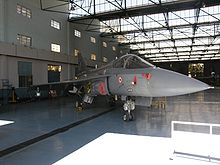 Tejas PV-3 in Indian Air Force grey camouflage pattern
Tejas PV-3 in Indian Air Force grey camouflage pattern
The maximum payload capability of Tejas is 5,300 kg (11,684 lb). [148] All weapons are carried on one or more of seven hardpoints with total capacity of greater than 5,000 kg: three stations under each wing and one on the under-fuselage centreline. An eighth offset station beneath the port-side intake trunk can carry a variety of pods like FLIR, IRST, laser rangefinder/designator, as can the centreline under-fuselage station and inboard pairs of wing stations. [34] [149] Auxiliary fuel tanks of 725, 800 and 1,200 litres can be carried under the fuselage to extend range. An aerial refuelling probe on the starboard side of the forward fuselage can further extend range and endurance. [150] RAFAEL's Derby fire-and-forget missile will serve as the Tejas' initial medium range air-air armament. [81] The Brahmos NG supersonic cruise missile is being developed for the Tejas. [151]
Stealth features have been designed into Tejas. [152] Being small provides an inherent degree of visual stealth, the airframe's high usage of composites (which do not reflect radar waves), a Y-duct inlet which shields the engine compressor face from probing radar waves, and the application of radar-absorbent material (RAM) coatings are intended to minimise its susceptibility to detection and tracking. [153]
Tejas uses Martin-Baker 16LG zero-zero ejection seat. [154] DRDO integrated an indigenous CSS, or canopy severance system, in the Tejas which allows the pilot to eject safely. [155]
Airframe
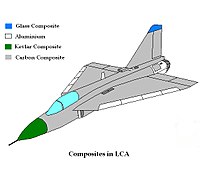 The use of various composites on Tejas
The use of various composites on Tejas
Tejas is constructed of aluminium-lithium alloys, carbon-fibre composites, and titanium alloys. [156] Composite materials make up 45% of the airframe by weight and 95% by surface area. Upper and lower wing skins are manufactured from a single piece of carbon-fibre reinforced polymer. Wing spars and ribs are also made out of carbon composites. [157] The percentage of carbon composites in the airframe by weight rose from 30% in the technology demonstrators to 42% in the prototype vehicles. The construction of elevons, tailfin, rudder, air brakes and landing gear doors use co-cured and co-bonded manufacturing techniques. The radome is made out of Kevlar, while the fin tip is made out of glass-fibre reinforced plastic. [154] Composite materials are used to make an aircraft lighter compared to an all-metal design, and the LCA's percentage employment of carbon-fibre composites is one of the highest among contemporary aircraft of its class. [158] Apart from making the plane much lighter, there are also fewer joints or rivets, which increases the aircraft's reliability and lowers its susceptibility to structural fatigue cracks. [159] The wing and fin of the compound-delta aircraft are of carbon-fibre-reinforced polymer, and were designed to provide a minimum weight structure and to serve as integral fuel tanks. [160] [161] The tailfin is a monolithic honeycomb structure piece, reducing the manufacturing cost by 80% compared to the "subtractive" or "deductive" method, involving the carving out of a block of titanium alloy by a computerized numerically controlled machine. No other manufacturer is known to have made fins out of a single piece. [162]
In 2001 it was envisaged that the naval variant would have nose droop to provide improved view for carrier landings, and wing leading–edge vortex controllers (LEVCON) to increase lift during approach. [21] The LEVCONs are control surfaces that extend from the wing-root leading edge and thus afford better low-speed handling for the LCA, which would otherwise be compromised by the increased drag that results from its delta-wing design. The LEVCONs should also increase controllability at high angles of attack (AoA). [163] The naval Tejas will also have a strengthened spine, a longer and stronger undercarriage, and powered nose wheel steering for deck manoeuvrability. [81] [164] The Tejas trainer variant will have "aerodynamic commonality" with the two-seat naval aircraft design. [165]
Avionics
The Tejas has a night vision goggles (NVG)-compatible "glass cockpit", domestically-developed head-up display (HUD) by Central Scientific Instruments Organization (CSIO), three 5 in x 5 in multi-function displays, two Smart Standby Display Units (SSDU), and a "get-you-home" panel with fail-operational/fail-safe air data computer (ADC) manufactured by Bharat Electronics Limited (BEL) that uses computational intelligence based autoland system to provide the pilot with essential flight information in case of an emergency and is connected with IAF ground station network to take over emergency controls of the unstable aircraft. The displays provide information on key flight systems and controls on a need-to-know basis, along with basic flight and tactical data. The pilot interacts with onboard systems through a multi-functional keyboard and several selection panels. The CSIO-developed HUD, Elbit-furnished DASH helmet-mounted display and sight (HMDS) with night-vision goggles compatible glass cockpit, [80] and hands-on-throttle-and-stick (HOTAS) controls reduce pilot workload and increase situation awareness by allowing access to navigation and weapon-aiming information with minimal need to spend time "head down" in the cockpit. [153]
The first 20 production Tejas Mk 1 equipped with hybrid version of the EL/M-2032 radar. It features look-up/look-down/shoot-down modes, low/medium/high pulse repetition frequencies (PRF), platform motion compensation, doppler beam-sharpening, moving target indication(MTI), Doppler filtering, constant false alarm rate (CFAR) detection, range-Doppler ambiguity resolution, scan conversion, and online diagnostics to identify faulty processor modules. [153] The Tejas Mk 1A will be equipped with an improved version of the EL/M-2052 AESA radar being developed jointly by Elta and HAL. [166]
The electronic warfare suite is designed to enhance combat survivability during deep penetration. The EW suite is developed by the Defence Avionics Research Establishment (DARE) with support from the Defence Electronics Research Laboratory (DLRL). This EW suite, known as Mayavi, includes a radar warning receiver (RWR), Missile Approach Warning (MAW) and a Laser warning receiver (LWR) system, Infrared & Ultraviolet Missile warning sensors, self-protection jammer, chaff, jaff and flares dispenser, an electronic countermeasures (ECM) suite and a towed radar decoy (TRD). In the interim, the Indian Ministry of Defence has revealed that an unspecified number of EW suites had been purchased from Israel's Elisra for the LCA prototypes. [167] [168] [169]
Tejas is also to be equippable with an infra-red search and track (IRST) sensor, which can detect and track thermal energy emissions, VHF to UHF radio communication with in-built counter-countermeasure system that supports air-to-air and air-to-ground mode connected via secure datalink network. [170] This system shall be pod-based, additional sensor pods are to include drop tanks for ferry flight/extended range/loitering time, FLIR targeting pod, ECM pods, Flares/Infrared decoys dispenser pod and chaff pod, EO/IR sensor pod, LITENING targeting pods, forward looking infrared (FLIR) sensor, and a laser designator/laser rangefinder, which can be used in various capacities, including reconnaissance, training, or attack. The identification friend or foe (IFF) system is developed by Centre for Airborne Systems (CABS). [34] [149] Tejas comes with flight utility system and management system (USMS) to monitor various parameters from sensors like ADA developed hybrid environmental monitoring and control system (EMCS), engine and electrical/electronics monitoring system (EEMS), digital fuel monitoring system (DFMS), digital hydraulics and brake management system (DHMS), MIL-STD-1760C stores management system and aircraft weapon management system (AWMS). Tejas uses various form of onboard navigation instruments like tactical air navigation (TACAN) system, terrain referenced navigation system (TERPROM), VHF omnidirectional range–instrument landing system (VOR–ILS), DARE developed enhanced ground proximity warning system (EGPWS) and ring laser gyroscope based inertial navigation system integrated with satellite guidance from Research Centre Imarat (RCI). [171] [172] [173]
Flight control system
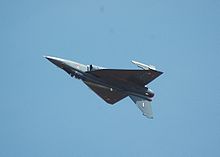 Tejas conducting an inverted pass
Tejas conducting an inverted pass
Since the Tejas is a relaxed static stability design, it is equipped with Aeronautical Development Establishment (ADE) developed full authority quadruplex fly-by-wire digital automatic flight control system (DAFCS) with fail-operational/fail-safe safety feature for automatic manoeuvre limiting and to ease pilot handling. The Tejas flight control system is operated with dual redundant modular MIL-STD-1553B standard databus and open architecture DIgital Flight Control Computer (DFCC) developed by Defence Avionics Research Establishment (DARE). The mission computer uses 32-bit processor based on Power ISA developed by Solid State Physics Laboratory (SSPL). [174] The Tejas aerodynamic configuration is based on a pure delta-wing layout with shoulder-mounted wings. Its advanced flight control surfaces actuators are all hydraulically actuated with dual redundant hydraulic system powered by quad redundant electrical power supply. The wing's outer leading edge incorporates three-section slats, while the inboard sections have additional slats to generate vortex lift over the inner wing and high-energy air-flow along the tail fin to enhance high-AoA stability and prevent departure from controlled flight. The wing trailing edge is occupied by two-segment elevons to provide pitch and roll control. The only empennage-mounted control surfaces are the single-piece rudder and two airbrakes located in the upper rear part of the fuselage, one each on either side of the fin. [175]
Propulsion
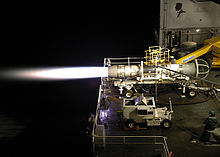 General Electric F404 engine during ground testing
General Electric F404 engine during ground testing
Early on, it was decided to equip prototype aircraft with the General Electric F404-GE-F2J3 afterburning turbofan engine while a program to develop a domestic powerplant led by the Gas Turbine Research Establishment (GTRE) was launched. [176] In 1998, after Indian nuclear tests, US sanctions blocked sales of the F404, leading to a greater emphasis on the domestic Kaveri. In 2004, General Electric was awarded a US$105 million contract for 17 uprated F404-GE-IN20 engines to power the eight pre-production LSP aircraft and two naval prototypes; [177] deliveries began in 2006. [178] In 2007, a follow-on order for 24 F404-IN20 engines to power the first operational Tejas squadron was issued. [177]
Cost overruns and delays were encountered in the Kaveri's development. [179] In mid-2004, the Kaveri failed high-altitude tests in Russia, ruling out it powering the first production Tejas aircraft. [178] [N 1] In February 2006, the ADA awarded a contract to French engine company Snecma for technical assistance on the Kaveri. [180] Using Snecma's new core, an uprated derivative of the Dassault Rafale's M88-2 engine, providing 83–85 kilonewtons (kN) of maximum thrust was being considered by DRDO. The IAF objected that since Snecma already developed the core of the engine, the DRDO will not be participating in any joint development but merely providing Snecma with an 'Indian-made' stamp. [181] In November 2014, the DRDO was submitting documents to cancel development of Kaveri. [81]
In 2008, it was announced that an in-production powerplant would have to be selected; this was required to be in the 95 to 100 kilonewton (kN) (21,000–23,000 lbf) range to execute combat manoeuvres with optimal weapons load. [182] [183] After evaluation and acceptance of technical offers for both the Eurojet EJ200 and the General Electric F414, the commercial quotes were compared in detail and GE's F414 was declared as the lowest bidder. The deal covered the purchase of 99 GE F414 engines, an initial batch will be supplied directly by GE and the remainder to be manufactured in India under a technology transfer arrangement. [184] [185] According to the IAF, adopting the new powerplant required a three-to-four years of redesign work. [186]
Operational history
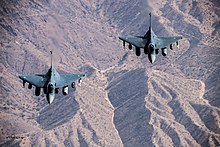 Tejas flying in formation to join Langkawi International Maritime & Aerospace Exhibition (LIMA) 2019
Tejas flying in formation to join Langkawi International Maritime & Aerospace Exhibition (LIMA) 2019
The formation of the first Tejas-equipped squadron started in July 2011. The Tejas entered service with No. 45 Squadron IAF (Flying Daggers) based at the Aircraft and Systems Testing Establishment at HAL, Bangalore on 1 July 2016 before being moved to Sulur Air Force Station in Coimbatore. [187] The squadron will initially have four aircraft. The IAF's Aircraft & Systems Testing Establishment will receive four aircraft already built including two development aircraft. [188]
In June 2017, Hindustan Aeronautics stated that it expects to have delivered 123 Tejas aircraft to the Indian Air Force by 2024–25. HAL outlined a three–pronged approach to accelerate aircraft production. It will build an additional assembly line, reuse the Hawk assembly line, and outsource major components to the private sector. [189]
The Tejas made its international debut on 21 January 2016, when two aircraft flew in the Bahrain International Air Show. [190] On 21 November 2016, the Indian Ministry of Defence proposed exporting the Tejas, with preliminary talks taking place with several friendly countries. [191]
The jet has solicited interest with the United Arab Emirates (UAE) with some discussions made during a visit by UAE Minister of State and Defence Mohammed Ahmed Al Bowardi Al Falacy during a state visit in October 2018 as part of growing defence relations between India and the UAE. [192] In January 2019, the Royal Malaysian Air Force issued a request for information to HAL regarding the Tejas for their light combat aircraft requirement. [193] In November 2019, Malaysia announced its interest to purchase the Tejas despite differences with India over Kashmir. [194]
The Tejas has participated in several military exercises, most recent being Gagan Shakti 2018 and Vayu Shakti 2019, after which the Indian Air Force Air Marshal Birender Singh Dhanoa commended its reliability and precision of air-to-ground payload delivery. [195] The 45 Squadron of LCA Tejas has successfully flown over 1,500 sorties during trials. During Exercise Gagan Shakti 2018, the eight Tejas deployed each flew six sorties per day. [196]
Variants
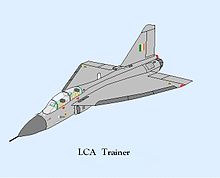 Tejas trainer variant
Tejas trainer variant
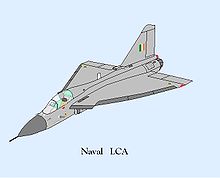 Tejas naval variant
Tejas naval variant
Prototypes
Aircraft already built and projected models to be built. Model designations, tail numbers and dates of first flight are shown
- Technology Demonstrators (TD)
- TD-1 (KH2001) – 4 January 2001
- TD-2 (KH2002) – 6 June 2002
- Prototype Vehicles (PV)
- PV-1 (KH2003) – 25 November 2003
- PV-2 (KH2004) – 1 December 2005
- PV-3 (KH2005) – 1 December 2006.
- PV-5 (KH-T2009) – 26 November 2009 – Fighter/Trainer Variant
- PV-6 (KH-T2010) – 8 November 2014 – Fighter/Trainer Variant. [78]
- Naval Prototypes (NP)
- NP-1 (KH-T3001) – Two-seat Naval variant for carrier operations. Rolled out in July 2010. [197] NP-1 made its first flight on 27 April 2012. [71]
- NP-2 (KH3002) – First flight on 7 February 2015 with ski-jump take-off and arrested landing required in STOBAR carrier. [198]
- Limited Series Production (LSP) aircraft
- LSP-1 (KH2011) – 25 April 2007. This LCA is powered by F404-F2J3 Engine. [199]
- LSP-2 (KH2012) – 16 June 2008. This is the first LCA fitted with F404-IN20 engine. [199]
- LSP-3 (KH2013) – 23 April 2010. The first aircraft to have the Hybrid MMR radar [61] and will be close to the IOC standard.
- LSP-4 (KH2014) – 2 June 2010. The first aircraft that was flown in the configuration that will be delivered to the Indian Air Force. [62] In addition to the Hybrid MMR, the aircraft flew with a Countermeasure Dispensing System and an identify friend or foe electronic system. [200]
- LSP-5 (KH2015) – 19 November 2010. IOC standard, with all sensors including night lighting in the cockpit, and an auto-pilot. [201]
- LSP-6 – Not built. [202]
- LSP-7 (KH2017) – 9 March 2012. APU intake has been aerodynamically reshaped.
- LSP-8 (KH2018) – First flight trial completed in March 2013. LSP 8 is the version that will go for production. [76]
Planned production variants
- Tejas Mark 1 (IOC standard) - Single-seat variant for Indian Air Force with Initial Operational Clearance. The 45 Squadron (Flying Daggers) operates 16 jets of this variant. All 16 IOC fighters will later be upgraded to FOC standard. [203] [204]
- Tejas Mark 1 (FOC standard) – Single-seat operational variant for Indian Air Force with Final Operational Clearance. All 16 jets to be inducted being BVRAAM capable, with general flight envelope expansion, increased angle of attack, higher g-limit of +8.5g, as well as aerial refueling probe and hot-refueling capability. [205]
- Tejas Mark 1 Navy - Single seat prototypes (NP1 & NP2) powered by F404 engines are used for the initial testing. The Naval variant of Tejas successfully completed testing in Goa during which the short take off (200 meter) from Shore Based Test Facility were carried out along with hot refuelling. The flight test from aircraft carrier is scheduled for 2017. [206] In December 2016, the navy stated that the aircraft is overweight for carrier operations. [207] As of 2019, the Indian Navy has ordered 8 Naval Tejas in Mk1 configuration, which includes 4 single seat fighters and 4 two seat trainers. [208]
- Tejas Trainer - Two-seat operational conversion trainer for the Indian Air Force.
- Tejas Trainer IN - Two-seat operational conversion trainer for the Indian Navy.
- SPORT - Supersonic Omni-Role Trainer aircraft is a two-seater Lead-in fighter training aircraft being developed from LCA Trainer Mark 1 for export purposes as light fighter. [209]
- Tejas Mark 1A - In 2015, ADA and HAL proposed an upgraded Tejas Mark 1A as a stop-gap aircraft until the Mark 2 came into production, which was delayed. [125] It is to include digital radar warning receivers, an external ECM pod and a self-protection jammer, AESA radar, ease of maintenance and improvement in avionics, aerodynamics, radar signature. [210] [126] However, initially HAL quoted a price of ₹463 crore (US$65 million) per unit for Tejas Mark 1A, which IAF the considered too high for a low-end aircraft. [211] After months of negotiation HAL agreed to lower the unit price to between ₹250-₹275 crore (US$39 million) for 83 Mark 1A and 10 Mark 1 trainer jets bringing the number to about Rs 22,825 crores. However this new deal would exclude all maintenance and support equipment. [49] Cost Committee of the Defence Ministry determined the final value of the deal to be at ₹45,000 crore (US$6.3 billion) including all installations and logistic packages. Signing of the contract for the aircraft will happen by December 2019 or January 2020, and delivery will start by 2023. [212]
- Tejas Mark 2 - The Tejas Mk 2, also called "Medium Weight Fighter", is to feature the more powerful General Electric F414-GE-INS6 engine with 98 kN of thrust. [134] [213] [117] In November 2009, Ministry of Defence sanctioned ₹2,431.55 crore (equivalent to ₹49 billion ;or US$690 million in 2019) for development of Tejas Mk 2, which was expected to be completed by 2018. However, a delay in procurement of engines pushed back the initiation of development till 2013. As of 2018, the project is expected to be completed by 2022. Mk 2 will feature an AESA radar, an on-board oxygen generation system, and a built-in electronic warfare suite among other improvements to avionics. [136] In January 2019, Air Chief Marshal Birender Singh Dhanoa said that the IAF has committed to procure twelve squadrons of Tejas Mk 2 aircraft. [214] In Aero India 2019, a model of Tejas Mk 2 with close-coupled canards was displayed. Mk 2 will be slightly larger with a length of 14.6 m (48 ft) and a wingspan of 8.5 m (28 ft). An increase in payload capacity to 6,500 kg (14,300 lb) will allow it to carry more weapons. It will include an infra-red search and track system and a missile approach warning system. [215]
- Tejas Mark 2 Navy - Twin and single-seat variants with strengthened airframe and telescopic landing gear for Indian Navy equipped for carrier operation including ski-jump take-off and arrested landing. [216]
Operators
-
Indian Air Force – 16 Tejas Mk 1 in IOC Configuration delivered, 40 Tejas Mk 1 ordered at a cost of INR 88 billion
(~US$ 1.25 billion), including 16 single-seat aircraft in IOC configuration, a further 16 in FOC configuration and eight twin-seat trainers.
[217]
IAF has
initiated procurement of a further 83 single-seat fighters in Mk 1A configuration and 10 twin-seat trainers at a cost of INR 390 billion (~US$ 5.45 billion)
[218]
with a request for proposal issued to HAL in December 2017.
[219]
[220]
An official order is expected to be placed by April 2020 and induction starting from 2023
onwards after delivery of first 40 Mark 1s end in March 2021.
[221]
[222]
-
Sulur Air Force Station
- No. 45 Squadron (Flying Daggers) [12]
- No. 18 Squadron (Flying Bullets) (Proposed) [223] [224]
-
Sulur Air Force Station
Specifications (Tejas Mk 1)
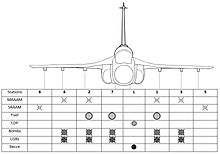 Weapon stations on Tejas
Weapon stations on Tejas
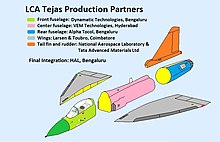 Tejas Production Partners
Tejas Production Partners
Data from tejas.gov.in,
[225]
DRDO Techfocus,
[226]
Jane's All the World's Aircraft,
[154]
Airforce Technology,
[227]
and Naval Technology
[228]
General characteristics
- Crew: 1 or 2
- Length: 13.2 m (43 ft 4 in)
- Wingspan: 8.2 m (26 ft 11 in)
- Height: 4.4 m (14 ft 5 in)
- Wing area: 38.4 m2 (413 sq ft)
- Empty weight: 6,560 kg (14,462 lb)
- Gross weight: 9,800 kg (21,605 lb)
- Max takeoff weight: 13,500 kg (29,762 lb)
- Fuel capacity: 2,458 kg (5,419 lb) internal; 2 × 1,200 l (260 imp gal; 320 US gal), 800 l (180 imp gal; 210 US gal) drop tank inboard, 725 l (159 imp gal; 192 US gal) drop tank under fuselage
- Payload: 5,300 kg (11,700 lb) external stores [148]
- Powerplant: 1 × General Electric F404-GE-IN20 turbofan, 53.9 kN (12,100 lbf) thrust dry, 90 kN (20,200 lbf) with afterburner [150] [229]
Performance
- Maximum speed: 2,205 km/h (1,370 mph, 1,190 kn)
- Maximum speed: Mach 1.8
- Range: 1,850 km (1,150 mi, 459 nmi)
- Combat range: 500 km (320 mi, 280 nmi) with internal tanks [230]
- Ferry range: 3,200 km (1,986 mi, 1,726 nmi) with 2x external drop tanks [230]
- Service ceiling: 16,240 m (53,030 ft)
- g limits: +8/−3.5
- Wing loading: 255.2 kg/m2 (52.3 lb/sq ft)
- Thrust/weight: 0.95
Armament
- Guns: 1x 23mm twin-barrelled GSh-23 cannon (burst fire rate of 50 rounds/second)
-
Hardpoints: 8 (1 × beneath the port-side intake trunk for targeting pods, 6 × under-wing, and 1 × under-fuselage) with provisions to carry combinations of:
- Rockets: S-8 rocket pods (expected) [232]
-
Missiles:
-
Bombs:
(supports CCRP/ CCIP mode)- ODAB-500PM
- ZAB-250/350
- BetAB-500Shp
- Sudarshan [239]
- KAB-1500L
- GBU-16 Paveway II
- Spice [240]
- HSLD-250/450/500
- FAB-500T
- DRDO SAAW
- DRDO glide bomb [239]
- FAB-250
- OFAB-250-270
- OFAB-100-120
- RBK-500 [232]
Avionics
-
HAL Tejas Mk 1
- Hybrid Elta EL/M-2032 multi-mode all weather fire control radar with day and night capability. [241]
- HAL Tejas Mk 1A
References
Notes
- Since India did not possess suitable aircraft, the high-altitude testing of the Kaveri was contracted to Russia, which used a Tu-16 bomber for the purpose. Another Kaveri engine was delivered to Russia for further flight testing from June to September 2006, this was tested on an Il-76 testbed instead of a Tu-16.
Citations
- PTI (17 January 2015). "After 32 years, India finally gets LCA Tejas aircraft" . Economic Times. Archived from the original on 29 March 2017. Retrieved 17 January 2015.
- "Tejas: IAF inducts HAL's 'Made in India' Light Combat Aircraft – 10 special facts about the LCA" . financialexpress.com. Archived from the original on 16 August 2016. Retrieved 1 July 2016.
- "Maiden Flight of FOC Standard LCA Tejas" . Hindustan Aeronautics Limited. Retrieved 17 March 2020.
- "EXCLUSIVE: With only two planes and issues unresolved, IAF to bring LCA Tejas home" . India Today. Archived from the original on 29 June 2016. Retrieved 1 July 2016.
- Shukla, Ajai (11 January 2014). "HAL pegs price of Tejas fighter at Rs 162 crore" . Business Standard.
- "Breakthrough for IAF: Cost for advanced version of indigenously made LCA Tejas slashed by Rs 18,000 crore" . India Today. 18 March 2020.
- "LCA first prototype vehicle to fly next month" . 21 August 2003. Archived from the original on 27 September 2011. Retrieved 30 June 2014.
- "Compund Delta Wing – Technology – Tejas – India's Light Combat Aircraft" . tejas.gov.in. Retrieved 25 February 2019.
- "Light Combat Aircraft (LCA)" . defencejournal.com. Archived from the original on 23 September 2015. Retrieved 1 July 2014.
- "Republic Day Parade 2014 – A Curtain Raiser" . Press Information Bureau . 25 January 2014. Archived from the original on 2 February 2014. Retrieved 27 January 2014.
- "Tejas: IAF inducts HAL's 'Made in India' Light Combat Aircraft – 10 special facts about the LCA" . The Financial Express. 1 July 2016. Archived from the original on 16 August 2016. Retrieved 1 July 2016.
- "Tejas begins operations from Sulur station" . The Times of India. The Times Group. 3 July 2018.
- "Indigenous content of Tejas 59.7% by value & 75.5% by numbers" . indianexpress.com. 18 November 2016. Archived from the original on 9 December 2017. Retrieved 9 December 2017.
- Pandit, Rajat (15 March 2018). "IAF commits to 324 Tejas fighters, provided a good Mark-II jet is delivered" . The Times of India. Retrieved 5 September 2019.
- Gady, Franz-Stefan (12 February 2019). "India's Air Force to Receive 4 More Tejas Light Combat Aircraft in March 2019" . The Diplomat. Retrieved 5 September 2019.
- Jain, Smriti (22 February 2019). "Tejas, indigenous light combat aircraft, gets FOC! HAL to roll out new LCA by year-end; what it means for IAF" . Financial Express. Retrieved 5 September 2019.
- "HAL rolls out 16th LCA Tejas for IAF" . The Economic Times. 25 March 2019. Retrieved 5 September 2019.
- "IAF may place order for improved Tejas variant: HAL chief" . Hindustan Times. 22 February 2019. Retrieved 6 September 2019.
- Shukla, Ashish (3 August 2019). "Tejas Mark II – Indigenous light combat aircraft targeted by 2022" . International Business Times Times of India. Retrieved 5 September 2019.
- Chatterjee, K. "Hindustan Fighter HF-24 Marut; Part I: Building India's Jet Fighter." . bharat-rakshak.com. Retrieved 23 August 2006. Archived 28 July 2013 at the Wayback Machine
- "The Light Combat Aircraft Story by Air Marshal MSD Wollen" . Archived from the original on 17 October 2013. Retrieved 9 December 2013. First published in Indian Aviation, Opening Show report, Aero India 2001.
- "Tejas Light Combat Aircraft (LCA)." Global Security, 2012. Retrieved 29 May 2012. Archived 10 January 2014 at the Wayback Machine
- Iyer, Sukumar R. "LCA: Impact on Indian Defense." Bharat Rakshak Monitor, March–April 2001. Retrieved 30 May 2012. Archived 11 October 2012 at the Wayback Machine
- "Remembrance of Aeronautical Matters Past." Vayu Aerospace & Defence Review, 2004. Retrieved 7 March 2009.
- "Light Combat Aircraft (LCA) Test-Flown Successfully." DRDO, January 2001. Retrieved 29 May 2012.
- Reddy, C. Manmohan. "LCA economics." The Hindu, 16 September 2002. Retrieved 29 May 2012.
- "LCA Tejas History" . Tejas.gov.in. Archived from the original on 17 October 2013. Retrieved 9 December 2013.
- "Dassault wins Indian LCA contract" . Flight International . London: Reed Business Information . 24 October 1987. Archived from the original on 22 December 2017.
- "LCA Tejas History: Genesis" . tejas.gov.in. Archived from the original on 25 September 2014. Retrieved 1 July 2014.
- "India's Light Combat Aircraft" (PDF). employmentnews.gov.in. Archived from the original (PDF) on 6 April 2014. Retrieved 1 July 2014.
- Frawley 2002 , p. 114.
- "ADFCS-II" . transport-research.info. Archived from the original on 14 July 2014. Retrieved 6 July 2014.
- "20th Anniversary Celebrations of the National Control Law Team" . nal.res.in. 10 June 2012. Archived from the original on 18 December 2012.
- "Tejas LCA: Light Multi-Role Fighter" . aerospaceweb.org. Archived from the original on 5 April 2016. Retrieved 1 July 2014.
- "Tejas / Light Combat Aircraft (LCA)" . fighter-planes.com. Archived from the original on 18 January 2015. Retrieved 6 July 2014.
- Taylor, Munson & Taylor 1989 , p. 104.
- Aroor, Shiv. "Indigenous' aircraft needs foreign lift, for its radar." The Sunday Express, 8 April 2006. Retrieved 30 May 2012. Archived 8 January 2016 at the Wayback Machine
- "India's flying Testbeds" . B Harry. acig.org. 12 September 2005. Archived from the original on 7 January 2012. Retrieved 1 July 2014.
- "Interview with Mr. Shyam Shetty, head of the National Control Law team: NAL and LCA-1: Flight Control Laws." National Aerospace Laboratories (NAL) Information Pasteboard, 25 June – 1 July 2001.
- Mudur, Nirad. "Glitches in LCA radar." Vijay Times, 1 May 2006. Retrieved 30 May 2012. Archived 2 June 2012 at the Wayback Machine
- "AESA Programme For Tejas Scans For Development Partner" . indian-military.org. Archived from the original on 13 March 2012. Retrieved 30 June 2014.
- Sharma, Ravi. "LCA to be fitted with Israeli multi-mode radar." The Hindu, (Chennai, India), 3 October 2008. Retrieved 30 May 2012. Archived 9 November 2012 at the Wayback Machine
- "Indigenous production of LCA soon." The Hindu, (Chennai, India), 4 August 2008. Retrieved 29 May 2012. Archived 9 November 2012 at the Wayback Machine
- Jane's All The World's Aircraft 1986–1987, John W.R. Taylor, Jane's Publishing Company Limited, ISBN 0 7106 0835 7 , p. 893
- "Zephyr 2009 – Celebrating the Spirit of Aviation – Aerospace Engineering, IIT Bombay" . aero.iitb.ac.in. Archived from the original on 3 September 2011. Retrieved 30 May 2011.
- "Times of India: HAL Tejas supersonic fighter jets inducted into Indian Air Force" . Archived from the original on 1 July 2016.
- "IAF to induct 8 squadrons 'Tejas' in 8 years: Manohar Parrikar" . The Economic Times. 26 February 2016. Archived from the original on 9 March 2016. Retrieved 28 February 2016.
- Menon, Jay (8 November 2016). "Indian Air Force To Get 83 Tejas Mk. 1-A Light Combat Aircraft" . Aviation Week. Archived from the original on 6 March 2017. Retrieved 5 March 2017.
- Kumar, Chethan (24 August 2019). "83 LCAs Order: HAL may finally agree to lower price" . The Times of India. Retrieved 5 September 2019.
- "Exporting the Tejas; Yay or Nay?" . 5 May 2019.
- "Indian MoD approves procurement of 83 Tejas LCA Mk 1A fighter aircraft" . Jane's 360, janes.com. Retrieved 19 March 2020.
- Pioneer, The. "DAC clears procurement of 83 indigenously manufactured LCA Tejas's advanced version" . The Pioneer. Retrieved 18 March 2020.
- Aroor, Shiv. "Finally, Decks Cleared For $5.2 Billion LCA Tejas Fighter Order" . Livefist. Retrieved 18 March 2020.
- "IAF to get Made in India jets: Know more about the LCA 'Tejas' Mk1A" . The Financial Express. 18 March 2020. Retrieved 19 March 2020.
- Sharma, Ravi. "IAF insists on changes to Tejas." The Hindu, 5 December 2008. Retrieved 30 May 2012. Archived 6 June 2013 at the Wayback Machine
- "Light combat aircraft flies with near-full gear." Daily News and Analysis, 23 April 2010. Retrieved 30 May 2012. Archived 3 October 2012 at the Wayback Machine
- Ravi Sharma (3 December 2006). "IAF team to oversee LCA induction and operation" . The Hindu. Archived from the original on 8 January 2016. Retrieved 6 July 2014.
- "HAL Tejas" . India TV News. 8 October 2013. Archived from the original on 14 July 2014.
- "Fighter aircraft Tejas clocks fastest speed during testing." The Indian Express, 8 December 2009. Retrieved 22 August 2011. Archived 15 May 2011 at the Wayback Machine
- "Tejas Trainer makes successful maiden flight" (PDF). Aeronautical Development Agency. Archived from the original (PDF) on 13 May 2014. Retrieved 6 July 2014.
- "LCA Set To Fly With Israeli Radar" . 22 April 2010. Archived from the original on 10 May 2011. Retrieved 30 June 2014.
- "First flight of Tejas aircraft LSP-4." The Times of India, 2 June 2010. Archived 8 January 2016 at the Wayback machine
- "Light combat aircraft Tejas undergoes second phase of hot weather trails." Daily News and Analysis. Retrieved 30 May 2012. Archived 3 October 2012 at the Wayback Machine
- "Indian LCA Undergoing Sea Trials" . Aviation Week & Space Technology. Archived from the original on 10 May 2011. Retrieved 30 June 2014.
- "Tejas debut flight operational configuration." Deccan Herald, 19 November 2010. Retrieved 15 February 2011. Archived 20 October 2012 at the Wayback Machine
- Krishnan M., Anantha. "Indian Navy fastens its seatbelt for Light Combat Aircraft Tejas." Daily News and Analysis, 23 June 2010. Retrieved 30 May 2012. Archived 26 September 2012 at the Wayback Machine
- "Air force to get 20 more Tejas fighter aircraft, says Antony" . livemint.com. 7 July 2010. Archived from the original on 10 May 2011. Retrieved 30 June 2014.
- "LCA Navy all set for ski-jump trials at SBTF Goa" . 8 December 2014. Archived from the original on 8 December 2014.
- "Print Release" . Archived from the original on 26 December 2014.
- "LCA Tejas" . sawfnews.com. Archived from the original on 30 November 2011. Retrieved 30 June 2014.
- Kumar, Chethan. "LCA naval variant's first flight on Friday." Deccan Herald, 25 April 2012. Retrieved 30 May 2012. Archived 2 February 2014 at the Wayback Machine
- Anandan, S. "Key Tejas weapon trials begin in Jaisalmer." The Hindu (Kochi, India), 20 September 2011. Retrieved 30 May 2012. Archived 1 December 2012 at the Wayback Machine
- "LCA Completes Successful Bombing Runs" , Defence news, IN, archived from the original on 2 July 2014, retrieved 17 September 2012
- "Flight Test News" . Aeronautical Development Agency. Archived from the original on 19 October 2013. Retrieved 30 June 2014.
- Shukla, Ajai. "After three months on ground, combat aircraft Tejas resumes test flight." Business Standard, 27 November 2012. Retrieved 29 November 2012. Archived 3 February 2013 at the Wayback Machine
- "Tejas LSP-8 makes its maiden flight." The New Indian Express, 1 April 2013. Retrieved 1 April 2013. Archived 23 October 2013 at the Wayback Machine
- "India's Light Combat Aircraft Tejas Completes 2,400 Sorties" . 12 December 2013. Archived from the original on 24 December 2013.
- "HAL successfully tested LCA Tejas PV-6" . defenceradar.com. 8 November 2014. Archived from the original on 8 November 2014.
- "Tejas LCA exports likely after operational induction." Domain-b.com. Retrieved 16 January 2013. Archived 19 October 2013 at the Wayback Machine
- "Light Combat Aircraft-Tejas Testing" . Frontier India. 24 August 2007. Archived from the original on 20 December 2015. Retrieved 10 December 2013.
- "LCA Tejas: An Indian Fighter – With Foreign Help" . Defense Industry Daily. 13 August 2013. Archived from the original on 11 September 2013. Retrieved 30 June 2014.
- "TOPINION | How good is Tejas?" . Indian Defence Research Wing. 16 March 2019. Retrieved 6 September 2019.
- "The Tejas fighter's role in war" . BUsiness Standard. 28 December 2013. Retrieved 6 September 2019.
- "How Lima Deployment Marked New High For India's Tejas" . FlightGlobal. 5 April 2019. Retrieved 6 September 2019.
- "Naval LCA Tejas clears key test, makes first-ever arrested landing" . The New Indian Express. Retrieved 13 September 2019.
- Peri, Dinakar (11 January 2020). "Naval variant of LCA Tejas successfully lands on carrier" . The Hindu. ISSN 0971-751X . Retrieved 11 January 2020.
- PTI (11 January 2020). "Naval version of Tejas lands on aircraft carrier in major milestone". . The Times of India. Retrieved 11 January 2020.
- "With ski jump, naval light combat aircraft takes off from INS Vikramaditya for 1st time" . Hindustan Times. 12 January 2020. Retrieved 14 January 2020.
- "LCA Tejas to level up with on-board oxygen system by early 2020, says DRDO" . The New Indian Express. Retrieved 20 April 2020.
- Prasad, K. V. "Tejas gets Initial Operational Clearance." The Hindu, (Chennai, India), 10 January 2011. Retrieved 30 May 2012. Archived 2 February 2014 at the Wayback Machine
- "Tejas begins operations from Sulur station" . The times Times of India. 3 July 2018. Retrieved 3 July 2018.
- Pandit, Rajat. "Tejas won't become fully operational before 2013." The Times of India, 5 October 2011. Retrieved 30 May 2012. Archived 5 October 2011 at the Wayback Machine
- "Rs 25k cr Tejas won’t be ready before 2015." The Times of India, 22 July 2012. Archived 22 July 2012 at the Wayback Machine
- M, By Anantha Krishnan. "Tejas inches closer to FOC; crucial trials coming up" . Mathrubhumi. Archived from the original on 8 March 2017. Retrieved 7 March 2017.
- "LCA Project" . Press Information Bureau, Government of India. 5 August 2013. Archived from the original on 29 November 2014. Retrieved 6 July 2014.
- "30 years in the making, Tejas aircraft finally gets initial operational clearance" . The Times of India. 20 December 2013. Archived from the original on 21 December 2013. Retrieved 20 December 2013.
- "Tejas Fires Missile, Clears Final Test; Big Step in Bangalore on December 20" . The New Indian Express. 8 December 2013. Archived from the original on 23 December 2013. Retrieved 20 December 2013.
- "Tejas all set to get certification for IAF induction" . The Hindu. 19 December 2013. Archived from the original on 20 December 2013. Retrieved 20 December 2013.
- "Key test for indigenous light combat aircraft Tejas today" . The Times of India. 20 December 2013. Archived from the original on 8 January 2016. Retrieved 20 December 2013.
- "Failure of Indian LCA Tejas" . Daily Mail. 1 December 2010. Archived from the original on 2 June 2012. Retrieved 30 June 2014.
- "Tejas LCA sprints towards IAF's frontline squadron" . Business Standard. 9 December 2013. Archived from the original on 13 December 2013. Retrieved 10 December 2013.
- "Tejas Needs to Cross 6 Milestones in 15 Months" . The New Indian Express. 19 December 2013. Archived from the original on 23 December 2013. Retrieved 19 December 2013.
- "Advanced Weapon Trials of Tejas Fighter Completed" . New Indian Express. 29 May 2014. Archived from the original on 1 June 2014. Retrieved 30 June 2014.
- RAGHUVANSHI, VIVEK (20 July 2014). "India's 20-Year Late LCA Faces Fresh Delays" . defensenews.com. Gannett Government Media. Archived from the original on 5 April 2016. Retrieved 20 July 2014.
- Peri, Dinakar (31 July 2018). "LCA clearance may take time" . The Hindu.
- "Tejas fires Derby missile in Jamnagar" . www.oneindia.com. Archived from the original on 6 February 2016. Retrieved 6 February 2016.
- "India's Tejas aircraft conducts test-firing of Derby air-to-air BVR missile" . airforce-technology.com. Archived from the original on 16 May 2017. Retrieved 15 May 2017.
- "Tejas successfully test-fires derby air-to-air beyond visual range missile" . intoday.in. Archived from the original on 17 May 2017. Retrieved 15 May 2017.
- Sudhi Ranjan Sen. "Tejas far behind competitors, not enough to protect Indian skies: IAF" Archived 11 November 2017 at the Wayback Machine . India Today , 10 November 2017.
- "Tejas world-class fighter jet, plays defined role: HAL chief" . indianexpress.com. 19 November 2017. Archived from the original on 1 December 2017. Retrieved 9 December 2017.
- "Interview with HAL CMD: 'No frozen standard of preparation of LCA… that's where delays are coming'" . indianexpress.com. 19 November 2017. Archived from the original on 1 December 2017. Retrieved 9 December 2017.
- "'Hot refueling' trial of LCA Tejas successful – Times of India" . The Times of India. Archived from the original on 28 February 2018. Retrieved 28 February 2018.
- Som, Vishnu (2 August 2018). "Back From Dead: Navy's Tejas Fighter Preps For Tests on Aircraft Carrier" . NDTV. Retrieved 2 March 2019.
- "Naval version of Tejas undergoes successful tests" . The Economic Times. 2 August 2018. Retrieved 2 March 2019.
- "Tejas completes key midair refueling trial" . The Times of India. Retrieved 15 September 2018.
- "HAL gets nod to produce weaponised version of LCA Tejas" . The Economic Times. Press Trust of India. 4 January 2019.
- Krishnan, Anantha, M (20 February 2019). "Tejas officially given Final Operational Clearance" . OnManorama.
- "FOC-Standard LCA Tejas takes to skies on maiden flight" . Livemint. 17 March 2020. Retrieved 17 March 2020.
- "Tejas Fighter Jet: First 'combat worthy' Tejas flies for 40 minutes | India News - Times of India" . The Times of India.
- "First Tejas FOC fighter takes to the skies with loads of upgraded features" . OnManorama. Retrieved 17 March 2020.
- "Wow! Tejas, 1st indigenous Light Combat Aircraft in Final Operational Clearance-standard, takes to skies" . The Financial Express. 17 March 2020. Retrieved 17 March 2020.
- "Government Auditor Faults Tejas Light Combat Aircraft Project, Says it Fails to Meet Air Force's Needs" . NDTV.com. 8 May 2015. Archived from the original on 12 May 2015. Retrieved 13 May 2015.
- Sen, Sudhi Ranjan (30 September 2015). "Despite Flaws, India to Induct Tejas Mark 1-A Fighter Aircraft" . ndtv.com. NDTV Convergence Limited. Archived from the original on 1 October 2015.
- Sharma, Ravi (5 December 2008). "IAF insists on changes to Tejas" . The Hindu.
- Shukla, Ajai (12 August 2015). "With Tejas Mark II years away, HAL asks air force to buy Tejas Mark 1-A" . Business Standard.
- Shukla, Ajai (27 October 2015). "IAF wants aerial refuelling, jammers, quick turnaround in new Tejas" . Business Standard.
- "Govt clears Rs 82,000 crore for new Tejas aircraft, choppers, Russian tanks" . Deccan Chronicle. Press Trust of India. 8 November 2016.
- Bedi, Rahul (20 December 2016). "India issues global tender for AESA radar and EW suites to equip Tejas LCA" . IHS Jane's Defence Weekly. Archived from the original on 21 December 2016.
- Bedi, Rahul (10 December 2018). "India selects IAI/Elta Systems radar and EW suite for Tejas LCA Mk 1A" . Jane's Defence Weekly. Archived from the original on 10 December 2018.
- "Tejas Mark 1A to fly by 2022, if defence ministry issues contract this year" . Business Standard. 22 February 2019. Retrieved 6 September 2019.
- Shukla, Ajai (21 December 2017). "Indian Air Force initiates Rs 33,000-cr buy of 83 Tejas fighters" . Business Standard.
- "Tejas' price can't come down" . Bangalore Mirror. 17 July 2018.
- "HAL to receive Rs 45,000 crore orders for 83 LCA fighters" . ANI News. 6 September 2019. Retrieved 7 September 2019.
- Waldron, Greg (22 January 2013). "India to obtain 99 GE F414 engines for Tejas Mk II" . Flightglobal.com. Archived from the original on 22 December 2017.
- "F414 turbofan engines" (PDF). GE Aviation. Archived (PDF) from the original on 2 July 2017.
- "Tejas Mk-II: India may avail consultancy from European manufacturers who bid for MMRCA deal" . The Economic Times. Press Trust of India. 11 July 2018.
- "TEJAS TO LEVEL UP WITH ON-BOARD OXYGEN SYSTEM BY EARLY 2020, SAYS DRDO" . Hrdots. 20 September 2019. Retrieved 20 April 2020.
- "Rajnath's LCA sortie: Why Onboard Oxygen Generating System is a boon for pilots" . Asianet News Network Pvt Ltd. Retrieved 20 April 2020.
- Tauro, Caron Natasha (20 February 2019). "Aero India 2019: ADA unveils Tejas AF Mk 2 Medium Weight Fighter" . Jane's Defence Weekly. Bangalore. Archived from the original on 20 February 2019.
- "DIAT system soon to monitor in-flight health of Tejas Mk-II - Indian Express" . archive.indianexpress.com. Retrieved 20 April 2020.
- "Navy rejects Tejas, says 'overweight' fighter does not meet its requirements" . indiatimes.com. Archived from the original on 6 December 2016. Retrieved 27 January 2017.
- "Indian Navy rejects naval version of Tejas LCA, seeks alternative – IHS Jane's 360" . janes.com. Archived from the original on 20 December 2016. Retrieved 27 January 2017.
- "India seeks new naval fighter to replace rejected Tejas LCA" . IHS Jane's 360. 26 January 2017. Archived from the original on 24 February 2017. Retrieved 23 February 2017.
- "Light Combat Aircraft for Indian Navy: DRDO updates naval aircraft's progress" . 2 December 2019.
- "NDTV Exclusive: First Look At Futuristic Variant Of India's Tejas Fighter" . NDTV.com.
- "LCA Tejas Technology – Compound Delta Wing" . Tejas.gov.in. Archived from the original on 17 October 2013. Retrieved 9 December 2013.
- "LCA and its Features" . ada.gov.in. Archived from the original on 9 July 2010. Retrieved 30 June 2014.
- "LCA | Series Production Phase" . Retrieved 15 September 2019.}}
- "Tejas given Initial Operational Clearance." Facenfacts.com, 10 January 2011. Retrieved 26 July 2013. Archived 4 February 2014 at the Wayback Machine
- "Tejas, India" . naval-technology.com. Retrieved 24 July 2012. Archived 21 October 2013 at the Wayback Machine
- "Government open to making BrahMos-NG" . sundayguardianlive.com. 21 May 2016. Archived from the original on 26 May 2016. Retrieved 1 July 2016.
- "Advantage India: Why DRDO claims that LCA Tejas is the 'best in its class'" . The Economic Times. 20 December 2013. Archived from the original on 5 April 2016. Retrieved 20 December 2013.
- "Tejas LCA exports likely after operational induction news" . Domain-b. 10 January 2011. Archived from the original on 19 October 2013. Retrieved 10 December 2013.
- Jackson, Paul; Peacock, Lindsay; Bushell, Susan; Willis, David; Winchester, Jim, eds. (2016–2017). "India".IHS Jane's All the World's Aircraft: Development & Production. Couldson. pp. 302–303. ISBN 978-0710631770 .
- "Canopy Severance System- Canopy Severance System of Fighter Aircraft DRDO" . drdo.gov.in. Archived from the original on 9 December 2017. Retrieved 16 December 2017.
- Mathews, Neelam (17 July 2006). "Light Steps: India's LCA may be moving at a sedate pace, but it's progressing nonetheless". Aviation Week & Space Technology. Vol. 165 no. 3. New York. p. 126. ISSN 0005-2175 .
- Dreger, Paul (February 2004). "SE Asia Indigenous Fighter Programmes". Military Technology. Vol. 28 no. 2. Bonne. pp. 28–30. ISSN 0722-3226 .
- Harry, B. "Radiance of the Tejas (2 Parts)." Vayu Aerospace & Defence Review, Vol. I, February 2005; Vol. II, April 2005. Archived 14 May 2013 at the Wayback Machine
- "LCA Tejas Technology – Composite Materials" . Tejas.gov.in. Archived from the original on 17 October 2013. Retrieved 9 December 2013.
- "Military Aircraft Directory Part 2" . Flightglobal. 11 August 1999. Archived from the original on 12 December 2013. Retrieved 9 December 2013.
- "Structure – Carbon Fibre Composite Wings" . DRDO. Archived from the original on 12 December 2013. Retrieved 9 December 2013.
- "Dreams lighten in LCA" . Prakash, Sqn. Ldr. B.G. 16 February 2001. Archived from the original on 4 March 2008. Retrieved 30 June 2014.
- Jebakumar, S.K. (March 2009). "Aircraft Performance Improvements – A Practical Approach" (PDF). DRDO Science Spectrum: 4–11. Archived (PDF) from the original
- Wollen, M. S. D., Air Marshal (Retd.) "The Light Combat Aircraft Story." Bharat Rakshak Monitor, March–April 2001. Retrieved 30 May 2012. Archived 11 October 2012 at the Wayback Machine
- "KH T 2009." Aeronautical Development Agency. Retrieved 24 September 2006. Archived 14 December 2013 at the Wayback Machine
- Ajai Shukla (25 October 2015). "Cutting-edge Israeli radar wins air force approval for Tejas fighter" . business-standard.com. Archived from the original on 27 October 2015. Retrieved 28 October 2015.
- "India orders over one hundred SIGMA 95 navigation systems from Sagem" . Sagem. 19 February 2008. Archived from the original on 13 December 2013. Retrieved 10 December 2013.
- Sharma, Rikeesh (January–March 2013). "Transformation of Indian Naval Aviation Post New Inductions" (PDF). Journal of Defence Studies, Institute for Defence Studies and Analyses. 7 (1): 42. ISSN 0976-1004 . Archived (PDF) from the original on 13 December 2013. Retrieved 10 December 2013.
- Raghuvanshi, Vivek. "India, Israel Propose Joint Electronic Warfare Venture." Rantburg, 24 July 2006. Retrieved 30 May 2012. Archived 2 February 2014 at the Wayback Machine "India, Israel Propose Joint Electronic Warfare Venture." Rantburg, 24 July 2006. Retrieved 30 May 2012. Archived 2 February 2014 at the Wayback Machine
- "EL/M-2032." Deagel.com. Retrieved 29 May 2012. Archived 12 December 2013 at the Wayback Machine
- Agrawal, Mada (2013). "Hybrid Environmental Control System for Military Aircraft" (PDF). Global Journal of Researches in Engineering Electrical and Electronics Engineering. 13: 5.
- Keerthi, Reddy (2013). "Environmental Control System of Military Aircraft, LCA" (PDF) . International Journal of Engineering Research and Technology. 6: 635–642.
- "Tejas: The Indian Light Combat Aircraft" (PDF). Aeronautical Development Agency. 20 April 2020. Retrieved 20 April 2020.
- Iype, George. rediff.com "Will the LCA fly?" Rediff.com, 5 December 2000. Retrieved 30 May 2012. Archived 8 May 2013 at the Wayback Machine
- "Aircraft digital flight-control: Airplane cockpit control" . aviationonline.info. 28 December 2013. Archived from the original on 14 July 2014. Retrieved 1 July 2014.
- "Tejas – India's Light Combat Aircraft" . India Times. 25 July 2013. Archived from the original on 15 July 2014. Retrieved 6 July 2014.
- "F404-GE-IN20 Engines Ordered for India Light Combat Aircraft" . GE Aviation. 7 February 2007. Archived from the original on 14 May 2014.
- "Fraud of Light Combat Aircraft – Tejas & Kaveris" .Brig. (retd.) GB Reddi. manamlagaru.com. 23 January 2013. Archived from the original on 14 July 2014. Retrieved 6 July 2014.
- Gunston, Bill (Ed.) (15 June 2006). "GTRE Kaveri" in Jane's Aero-Engines, Issue 14. Coulsdon, Surrey, UK: Jane's Information Group Limited. ISBN 0-7106-1405-5 .
- Jackson, Munson & Peacock 2005 , p. 195.
- "Air Force says DRDO stalling Tejas fighter engine" . Business Standard. 28 June 2010. Archived from the original on 14 July 2014. Retrieved 6 July 2014.
- Sharma, Ravi. "Kaveri engine programme delinked from the Tejas." The Hindu, (Chennai, India), 27 September 2008. Retrieved 29 May 2012. Archived 3 November 2012 at the Wayback Machine
- Raghuvanshi, Vivek. "Eurojet Bolsters Engine Offer for India's LCA." Archived 5 April 2016 at the Wayback Machine Defense News, 4 January 2010. Retrieved 29 May 2012.
- Shukla, Ajai. "American engine to power LCA." Bharat-Rakshak.com, 1 October 2010. Retrieved 30 May 2012. Archived 11 October 2012 at the Wayback Machine
- "India picks GE's F414 for Tejas MkII fighter." Flight International, 1 October 2010. Retrieved 30 May 2012. Archived 9 August 2011 at the Wayback Machine
- "Defence Ministry plans to revive Tejas." Archived 14 May 2014 at the Wayback Machine Hindustan Times. Retrieved 30 May 2012.
- "IAF begins establishing first LCA squadron." Deccan Herald. Retrieved 30 May 2012. Archived 20 December 2013 at the Wayback Machine
- "Squadron Formation Still a Distant Dream for Air Force" . The New Indian Express. 20 December 2013. Archived from the original on 23 December 2013. Retrieved 20 December 2013.
- Peri, Dinakar. "Air Force likely to get 123 LCA Tejas by 2024–25" . The Hindu. Archived from the original on 19 March 2017. Retrieved 29 June 2017.
- "Tejas is a pilot's delight" . Bharat Shakti. Archived from the original on 25 January 2016. Retrieved 26 January 2016.
- "Export of LCA Tejas" . Press Information Bureau. 18 November 2016.
- Gurung, Shaurya Karanbir (17 October 2018). "UAE 'interested' in HAL-made light combat aircraft Tejas" . The Economic Times.
- Abas, Marhalim (5 February 2019). "Malaysia's Priorities: LCAs And Surveillance Drones" . Aviation Week & Space Technology.
- "Malaysia considers purchase of Indian jet fighters" . Nikkei Asian Review.
- "India's 1st self-made fighter jet, LCA Tejas, formally joins Air Force" . The Asian Age. 21 February 2019.
- "Tejas proves its mettle in biggest Indian war exercise Gagan Shakti 2018" . Business Standard. 25 April 2018.
- "We hope to sign the deal for 83 LCA-Mk1A within next three months, says Bhadauria" . The Hindu. Retrieved 19 May 2020.
- "PIBNaval Version of Light Combat Aircraft Rolls out a Defining and Memorable Occasion for the Nation -Antony." pib.nic.in. Retrieved: 30 May 2012. Archived 5 August 2011 at the Wayback Machine
- "Maiden flight by 2nd prototype of LCA Tejas' naval variant" . The Economic Times. 7 February 2015. Archived from the original on 5 April 2016. Retrieved 7 February 2015.
- "India flies another Tejas" . Aviation Week & Space Technology. 19 June 2008. Archived from the original on 10 May 2011. Retrieved 30 June 2014.
- Shukla, Ajai. "Tejas boosts test programme." Business Standard. Retrieved 22 November 2011. Archived 4 October 2012 at the Wayback Machine
- "India To Fly Tejas LSP-5 Soon" . Aviation Week & Space Technology. 1 November 2010. Archived from the original on 10 May 2011. Retrieved 30 June 2014.
- "Union Performance Defense Design Manufacture Light Combat Aircraft" (PDF). cag.gov.in. Archived (PDF) from the original on 5 November 2016. Retrieved 15 May 2017.
- "Tejas all set to get certification for IAF induction" . The Hindu. 19 December 2013. Archived from the original on 20 December 2013. Retrieved 20 December 2013.
- "Key test for indigenous light combat aircraft Tejas today" . The Times of India. 20 December 2013. Archived from the original on 8 January 2016. Retrieved 20 December 2013.
- "India's fighter jet 'LCA Tejas' now fully combat-ready; gets Final Operational Clearance" . Jagranjosh. 21 February 2019.
- Business Standard. "Naval Tejas successfully tested in Goa, will fly off aircraft carrier next year" . business-standard.com. Archived from the original on 5 June 2016. Retrieved 11 May 2016.
- "Navy rules out deploying 'overweight' Tejas on aircraft carriers" . indianexpress.com. 2 December 2016. Archived from the original on 20 December 2016. Retrieved 27 January 2017.
- Roy, Indranil; Rane, Nilesh (15 October 2019). "A Detailed Look at the Design Evolution of India's Naval-LCA Mk1 Fighter" . delhidefencereview.com. Retrieved 4 November 2019.
- "HAL's Supersonic Omni Role Trainer Aircraft (SPORT) gets IAF Backing" . IDRW NEWS NETWORK. 8 July 2019.
- PTI. "Advanced version of Tejas light combat aircraft makes its debut flight" . HT Media Limited. Press Trust of India. Retrieved 18 March 2020.
- "Why the Tejas cost is high" . Security Wise. 29 June 2018. Retrieved 7 September 2019.
- "HAL to receive Rs 45,000 crore orders for 83 LCA fighters" . aninews.in. Retrieved 6 September 2019.
- "F414 turbofan engines" (PDF). GE Aviation. Archived (PDF) from the original on 2 July 2017.
- Peri, Dinakar (31 January 2019). "IAF chief flags delays in manufacture of equipment" . The Hindu.
- Tauro, Caron Natasha (20 February 2019). "Aero India 2019: ADA unveils Tejas AF Mk 2 Medium Weight Fighter" . Jane's Defence Weekly. Bangalore. Archived from the original on 20 February 2019.
- "India test flies naval variant of LCA" news18.com, 28 April 2012. Retrieved 26 February 2019. Archived 13 May 2014 at the Wayback Machine
- Singh, Rahul; HT. "HAL needs new orders to prevent complete halt of production after 2021-22" . ThePrint. Retrieved 7 February 2020.
- Bedi, Rahul. "Indian MoD concludes price negotiations with HAL for 83 LCA Mk 1A combat aircraft" . Jane's Information Group. Retrieved 19 February 2020.
- Dominguez, Gabriel (28 February 2018). "India's LCA Tejas demonstrates hot refuelling capability" . IHS Jane's Defence Weekly. Archived from the original on 16 March 2018.
- Krishnan, Anantha, M (23 June 2018). "IAF, HAL end impasse over Tejas trainers" . OnManorama.
- "We hope to sign the deal for 83 LCA-Mk1A within next three months, says Bhadauria" . The Hindu. ISSN 0971-751X . Retrieved 19 May 2020.
- "HAL on a war-footing to roll out 4 new Tejas variants in 3 months" . english.manoramaonline.com. Retrieved 15 February 2020.
- "PVC recipient Sekhon's squadron to fly again" . The Tribune. Retrieved 23 November 2017.
- Anantha Krishnan M. "Air Chief Marshal Bhadauria interview" . OnManorama. Retrieved 27 February 2020.
- "Leading particulars and performance." tejas.gov.in. Retrieved 19 December 2017. Archived 21 December 2017 at the Wayback Machine
- "DRDO TechFocus." Archived 22 March 2011 at the Wayback Machine DRDO, February 2011. Retrieved 10 December 2012.
- "Tejas Light Combat Supersonic Fighter" . Airforce Technology. Verdict Media Limited. Retrieved 4 April 2020.
- "Tejas Light Combat Aircraft" . Naval Technology. Verdict Media Limited. Retrieved 6 April 2020.
- "LCA Tejas Specifications – Powerplant" . tejas.gov.in. Archived from the original on 17 October 2013. Retrieved 20 December 2013.
- "PICTURES: India's Tejas receives initial operational clearance" . FlightGlobal.com. 26 December 2013. Archived from the original on 13 November 2017.
- "Tejas Trials: Tejas Light Combat Aircraft Enters Key Test Phase". Aviation Week & Space Technology. Vol. 173 no. 17. New York: Informa. 11 April 2011. pp. 26–27. ISSN 0005-2175 .
- "Astra Beyond Visual Range (BVR) Air-to-Air Missile" . Air Force Technology. Verdict Media Limited. Retrieved 4 April 2020.
- "BVR missile test-fired from Tejas" . The Tribune. New Delhi. Press Trust of India. 28 April 2018.
- Majumdar, Sayan (September–October 2014). "Tejas Redux: The Israeli Touch". Vayu Aerospace and Defence Review. No. 5. Society for Aerospace Studies. pp. 82–84.
- "India moves towards broad adoption of ASRAAM" . FlightGlobal. 23 August 2019. Retrieved 7 September 2019.
- "India likely to induct air-launched BrahMos-A by early 2020" . Jane's 360. 25 February 2019. Retrieved 7 September 2019.
- "Captive flight trials of anti-radiation missile soon" . The Hindu. The Hindu Group. 17 February 2016. Archived from the original on 20 February 2016. Retrieved 18 February 2016.
- "HAL to hike Tejas output as India approves order". Flight International. Vol. 190 no. 5563. London: Reed Business Information. 15–21 November 2016. p. 20. ISSN 0015-3710 .
- "Indian Air Force Plans Israeli Spice Smart Bombs for HAL Tejas" . The EurAsian Times. Retrieved 6 April 2020.
- "LCA Tejas finally gets Radar!" . Defence Aviation. 30 April 2010. Archived from the original on 5 April 2016. Retrieved 1 March 2016.
- Pubby, Manu. "Israeli super radars set to give desi LCA fighter jet enhanced combat capability" . The Economic Times. ET Bureau. Retrieved 2 March 2020.
- Franz, Stefan Gady. "India Selects Israeli Radar and Electronic Warfare Suite For Tejas Light Combat Aircraft" . The Diplomat. Diplomat Media Inc. Retrieved 2 March 2020.
- Ajai Shukla. "Rs 26k-crore order for building Tejas Mark 1A to open door for Mark 2" . Business Standard. Retrieved 16 December 2019.
Bibliography
- Jackson, Paul; Munson, Kenneth; Peacock, Lindsay, eds. (2005), "ADA Tejas",Jane's All The World's Aircraft 2005–06 (96th ed.), Coulsdon, Surrey, UK: Jane's Information Group Limited, ISBN 978-0-7106-2684-4
- Taylor, John W. R.; Munson, Kenneth; Taylor, Michael J. H., eds. (1989), "HAL Light Combat Aircraft", Jane's All The World's Aircraft 1989–1990, Coulsdon, Surrey, UK: Jane's Information Group Limited, ISBN 978-0-7106-0896-3
- Frawley, Gerard (2002), The International Directory of Military Aircraft, Manly NSW, Australia: Aerospace Publications Pty Ltd, ISBN 1-875671-55-2
- Hoh, Roger H.; Mitchell, David G. (September 1983), Flying Qualities of Relaxed Static Stability Aircraft – Volume I: Flying Qualities Airworthiness Assessment and Flight Testing of Augmented Aircraft (PDF), Federal Aviation Administration, archived from the original (PDF) on 16 December 2008, retrieved 16 June 2008
- Aronstein, David C.; Piccirillo, Albert C. (1996), The Lightweight Fighter Program: A Successful Approach to Fighter Technology Transition, Reston, Virginia: AIAA, ISBN 978-1-56347-193-3
External links
Features and analysis:
- "Flying into the unknown" — A feature by The Hindu on the Tejas test pilots .
- "LCA and Economics" by Sunil Sainis and George Joseph
- "The Light Combat Aircraft Story" , by Air Marshal MSD Wollen (Retd).
- The case to support the indigenous LCA programme , by Ashok Parthasarathi and Raman Puri.
Technical:
- An Approach to High AoA Testing of the LCA
- Development Flight Testing of the Tejas Light Combat Aircraft
- LCA Avionics And Weapon System Mission Computer Software Development: A Case Study
- TEJAS The Indian Light Combat Aircraft, official brochure 2015
- ADA Tejas IOC brochure
- Environmental Control System of Military Aircraft, LCA
- Hybrid Environmental Control System for Military Aircraft
General:
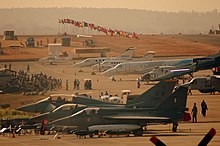 Tejas parked next to
Tejas parked next to 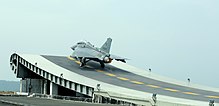 Tejas NP-1 takes-off from
Tejas NP-1 takes-off from 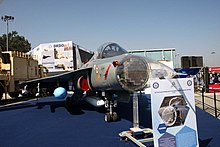
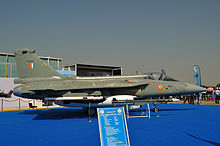 Tejas carrying
Tejas carrying 